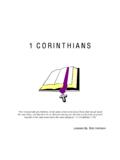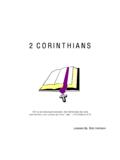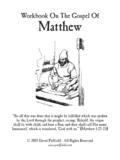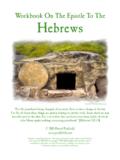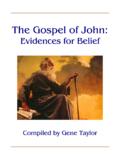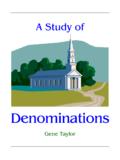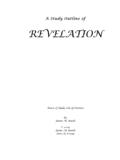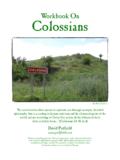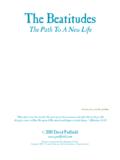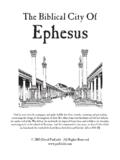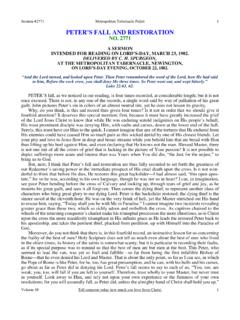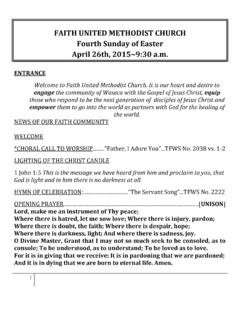Transcription of Sermon Outlines On James - padfield.com
1 Be Perfect Sermons on James Keith Sharp But let patience have her perfect work, that ye may be perfect and entire, wanting nothing.. ( James 1:4). Table of Contents Lesson Passage Page 1. Introduction to James 1. 2. Triumph Through Trials 1:2-12 5. 3. Don't Blame God 1:13-17 7. 4. Receive the Word 1:18-21 9. 5. Be Ye Doers of the Word 1:22-25 10. 6. Vain Religion/Pure Religion 1:26-27 12. 7. Respect of Persons 2:1-9 14. 8. Just One Little Sin 2:10-13 15. 9. Faith & Works 2:14-26 16. 10. The Tongue: Small But Powerful 3:1-12 19.
2 11. Two Wisdoms 3:13-18 21. 12. War & Peace 4:1-10 23. 13. Speak Not Evil One of Another 4:11-12 24. 14. Life without God 4:13-17 25. 15. Poor Rich Men 5:1-6 26. 16. Patience 5:7-11 27. 17. Swear Not 5:12 28. 18. Life's Changing Scenes 5:13-16 30. 19. The Power of Prayer 5:13-18 32. 20. If Any of You Do Err 5:19-20 33. Lesson 1. Introduction to James I. Attestation A. external evidence 1. Eusebius, who put it among the disputed books, accepted it for himself, referring to it as the first of the Catholic Epistles and as used publicly in the churches along with other epistles (Harrison, p.)
3 383). 2. The Muratorian Canon omits it (Thiessen, p. 272). 3. The old Syriac Version included it (Ibid). 4. Although there may be allusions to James in the Apostolic Fathers, the first writer to refer to the work by name and cite it as Scripture is Origen, in his Commentary on John (Harrison. 382-3). 5.. Origen recognized James as Scripture, as did also Cyril of Jerusalem, Gregory of Nazianzus, Athanasius, Jerome, and Augustine (Thiessen, p. 273). 6. And it is included in the catalogues of accepted books that have come down to us from Asia Minor and Egypt (Ibid).
4 7. It was not until the Third Council of Carthage ( 397) that the Epistle of James came to be generally recognized as canonical (Ibid). 8. Luther gave the book a secondary position in the Lutheran Bible because it contradicted his belief in salvation by faith alone. He called it a right strawy epistle (Harrison, ). B. internal evidence The Epistle harmonizes with what we know of this James from Josephus (Ant. XX. ix), from the Book of Acts (15:13-21; 21:17-25), and from Galatians (1:19; 2:9,10), and with the known circumstances of the Jewish Christians in the Dispersion (Ibid).
5 II. Author: James - 1:1. A. There are three or four (cf. Luke 6:16; KJV and ASV) New Testament characters named James .. 1. the son of Zebedee, an apostle - Matthew 4:21; 10:2. 2. the son of Alphaeus, an apostle - Matthew 10:3; Mark 15:40. 3. the Lord's brother - :55; Galatians 1:19. B. Which James wrote this book? 1. He does not call himself an apostle. - 1:1. 2. James , the son of Zebedee, was murdered by Herod in 44. (This does not rule him out as the author, for conditions in harmony with the content of the book were present before his death.)
6 - cf. Date ) - Acts 12:1-2. 3. Nothing is known scripturally of James the less after the establishment of the church. 4. James , the Lord's half brother, became prominent in the first century church. - 1 Corinthians; 15:7; Acts 1:14; Galatians 1:18-19; Acts 12:17; 15:13,19; Galatians 2:1,9-10,12; Acts 21:18. 1. 5. This James became so prominent that he wascharacteristically referred to by his name alone. - cf. Galatians 1:19; 2:9,12. 6. The greeting of 1:1 is similar to that of James , the Lord's brother, in Acts 15:23.
7 No other New Testament epistle begins this way. 7. By far, the most likely author is James , the brother of the Lord. III. Date A. If James (the brother of the Lord - ) wrote the Epistle, then we must date it before 62 or 63, for according to Josephus that was the time when he was killed' (Ibid. 277). B. It must have been written after Acts 8:1-4, for the disciples were scattered abroad.. C. It must have been written after Acts 11:26, for apparently the name Christian was already in use. - 2:7. D. It apparently was written before Acts 15, because: 1.
8 There is no mention of the decision of the apostles and elders concerning the Gentiles and the law, even though James was a chief architect of that decision. - Acts 15:13-21. 2. There is no mention of Jewish/Gentile relations, although James specifically deals with respect of persons. - 2:19; cf. Acts 10:34-35. 3. Disciples were still meeting in synagogues (Or James uses the Jewish term synagogue . for their worship assembly). - 2:2. 4. A date around the time of the world-wide famine ( 44) would fit, because of the reference to widows and orphans.
9 - 1:26-27. E. The book may have been written around 44. IV. Audience: Christians Everywhere - 1:1,18; 2:1; cf. Acts 8:1-4; 11:19-26. V. From Where Written Though the place of composition is not specifically indicated by the author, certain incidental allusions enable us to determine with a fair degree of certainty where the Epistle of James was written. The reference of the writer to the early and latter rain'. ( James 5:7), is a strong intimation that it was written in the land of Palestine. This division of the rainy season was characteristic of the land, and quite familiar to all who lived, or ever had lived, there.
10 There were springs which produced sweet water;. others gave forth only salt water (3:11); and the land produced wine, figs and oil (3:12). These considerations point to Palestine as the land in which the author lived;. and, inasmuch as James is prominently mentioned in connection with the church in Jerusalem (Acts 15:13-21), it seems reasonable to suppose that the Epistle was written from Jerusalem in the land of Palestine (Woods. 19). VI. Theme: Be Perfect - 1:4,17,25; 2:22; 3:2. 2. VII. Characteristics A. One of Seven Catholic Epistles.
